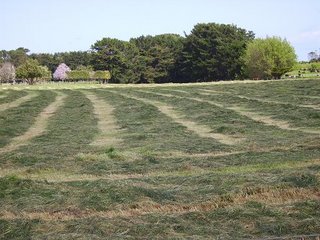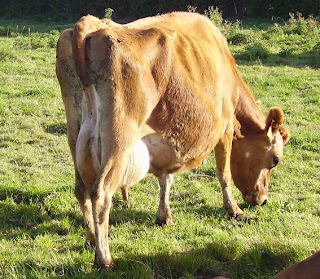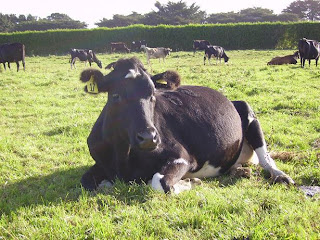Cows, calves and veterinary
Tuesday, October 24, 2006
Sunday, October 22, 2006
Pre-ruminant calf nutrition
The various calf feed companies have spent this spring mudslinging amongst themselves with greater vigour than usual, contradicting each other in the name of Science.It’s no wonder the ignorant farmer is confused. The information he needs to make decisions is held securely by the salesmen of the large companies. The laws of Nature have changed, they tell him, and he can no longer expect to produce a healthy calf without their product.
Nearly a decade has passed since I was able to walk into a local library and obtain the latest in animal research. Like everyone else, I’m dependent on the information obtained through the rural press, from vets and from the feed salesmen. Any observations contracting their wisdom are merely that – personal observations, anecdotal evidence and of no import.
And pictorial evidence, of course.

“Give them the right stage colostrum for their age,” PWD emphasises. As much day one colostrum as they can drink, offered twice daily when they come into the shed. Second and third milking colostrum on their second day and older colostrum until 5 – 7 days old, when they are moved to the other shed and fed once daily with access to grass, shelter and good quality hay.
That’s it. Plenty of milk, plenty of grass, wean at two months old and keep offering them the young, leafy grass ahead of the cows until they’re eight – ten months old.
I’ve never seen better calves yet.


These are my calves, 2004 (Xbreds) and 2005 born (Jerseys). They’ve been reared on a restricted milk/ ad lib meal system (4 litres/calf reconstituted milk powder) and weaned at 65 kg and 6 – 7 weeks old (2004) or 8 – 9 weeks old (2005 following rotavirus outbreak). They were put out to grass for the first time at three or four weeks old and ate increasing rates of meal (up to 1 kg preweaning, increased to 1.5 or 2 kg) until weaning, then reducing rates until ten – twelve weeks old. Each group of fifty calves munched through one large round bale of hay, offered adlib, before they were twelve weeks old. Meal used – NRM Moozlee and NRM Grow-up, about 35 – 40 kg per calf.

The 2006 line were moved on to whole milk at around a week old, offered 6 litres a day with adlib meal and hay until about four weeks old, when they were cut back to four and a half fed once daily and let out to grass (the later born calves were at grass from around a week old). The milk was cut back again to three litres when the stored colostrum ran out and the first calves weaned at eight to nine weeks old and 70 – 80 kg.
In spite of being offered fresh meal daily, they’ve eaten about 6 – 7 kg a calf pre-weaning and I’m still trying to persuade them to munch through the last four bags and wondering when to call it quits and just offer the stuff to the dairy cows. They eat more meal when they don’t have access to large quantities of sweet grass. Meal used – StartUp 3 – 4 kg per calf, FinishUp about 4.5 kg per calf thus far. They’ve eaten the usual 5-bale equivalent of hay per 25 calves.
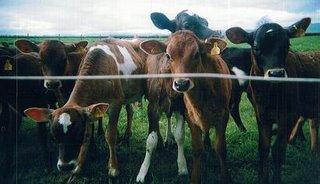
A milk/meal/delayed forage system – though not as delayed as some rearers who would keep their calves inside until weaning. These calves are fed large quantities of milk (5 – 7 litres) for the first three weeks, then reduced milk is offered and meal consumption increases. Calves are reared on NRM Moozlee and go out to grass at five or six weeks old, weaned at eight to ten weeks.
I don’t have photos of calves reared on the ChaffHage system (Lucerne silage), though I have worked briefly on farms that reared their calves that way – calves looked fit and healthy. Likewise I don’t have photos of the calves reared on my farm last year – which I had nothing to do with beyond training the babies and turning healthy four day old calves over to the ‘official calf rearer’ to destroy *shudders*. That system was 3.5 litres of milk once daily, adlib meal (looked like a chipped grain mix) and calves weaned from deep wet compost onto grass and continued meal feeding at five to six weeks and 65 kg on the weigh band (Fr bulls). Calves did not look fit and healthy.
Recently calf rearers across New Zealand have been incorporating palm kernel extract into the calf feed (and it’s also included in the mix produced by the large calf meal companies). I haven’t seen calves reared this way, but I’ve been told they grow well.
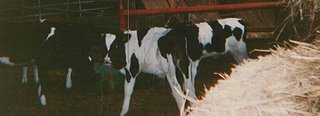
These calves are raised in group pens on deep straw beds, and offered 2 – 3 litres milk twice daily until four or five weeks old, then trough-fed milk for as long as it is available, until three to five months (if I recall correctly). They have adlib hay and home-mix meal (rolled barley, maize gluten, distillers grains and sometimes sugarbeet/soy products, fortified with minerals) until turn out in spring (May, Scotland). Because of the long winter and AYR calving, the calves range from three months to twelve months when first turned out to grass, and the older ones will have been fed silage indoors rather than hay. Meal feeding is almost lifelong.
*note* Because of the milk quota system in place in Britain, it is cheaper to give milk that is surplus of quota to calves five and six months old than to supply it to the dairy company. Farmers would even feed it to their cows, as a reasonable alternative to tipping it down the drain or paying the penalty for being over their quota.
Rather than being confused by the science, if we look at the basics of calf rearing the aim is to achieve two things: first, a living, healthy calf; second, a functioning rumen that will allow the young animal to get most of its nutrients from forage.
A baby calf cannot survive on hay or grass any more than you or I can. So first of all, to keep our calf alive it needs energy that doesn’t come from forage: colostrum first, to stimulate the digestive system and provide immunity and energy, then milk for energy and growth.
That keeps the calf alive. Until it’s around a week old that’s all it will be interested in – I’ve never succeeded in persuading a calf less than that age to eat meal or hay or drink water from a trough in any significant quantities.
At about a week old, if it was outside with its mum the calf would be drinking from her at least twice daily and will start to nibble at the grass and any other vegetation it finds. From now on it will spend increasing amounts of time grazing and by about three or four weeks old, will chew cud when resting. The suckled calf is weaned at six to nine months old far bigger and fatter than any hand-reared calf of the same age – and with a fully functioning rumen.
Not all calves are lucky enough to keep a mummy cow all to themselves for their first six months of life – but the principles are the same. Give them a food they can digest that will provide for energy and growth, for at least the first eight to ten weeks of life, and allow them access to a feed that will stimulate rumen development. Grass will do it. Hay will do it. Chaffhage will do it also. The meal companies tell us meal will do it (I’m inclined to be suspicious on this one, because I’ve never seen calves regurgitating to cud on their meal). They love clean straw, or a sweet dry silage.
From 3 – 4 weeks old, calves have a strong drive to eat anything long and stringy. If they can’t have grass or hay, they’ll chew the rearer’s hair or their bedding or the fenceposts.
So why do calves need meal?
Meal fits into a calf rearing system in a number of ways. It can be an energy substitute for milk, allowing early weaning, lighter weaning or a restricted milk system. It’s a balanced diet, with protein, carbohydrate and usually a sweetener (molasses or sugarbeet pulp) for palatability. The companies producing bagged calf meals fortify it with minerals and a coccidiostat, to help maintain the calves in good health.
It can be used to help the calves get through weaning without a growth check.
It’s useful for making them follow you.
But it’s not an essential. The main advantage of meal is in reducing the amount of milk fed to the pre-ruminant and developing ruminant animal. And once the animal is keen on the idea of eating meal, it can be provided as an energy source at any point in its life.
In a group of calves at risk of coccidiosis, it’s an easy way to administer the preventative. But all is not lost if the farmer chooses to not feed meal – the coccidiostat added to calf meal is bovatec. It’s available from the vet, and can be manually administered to the calf (not a pleasant job, believe me. On one farm I saw coccidiosis every year when trying to wean the calves off meal) or mixed with other feeds (not fluids unfortunately).
Baycox is an oral drench effective at treating coccidiosis – now certified for use in calves. I’ve been told it also has some preventative effect.
My biggest problem with coccidiosis has been trying to convince a vet or vet receptionist of my ability to identify it without calling a vet out, waiting 48 hours for faecal lab tests and then obtaining the appropriate treatment (without being fobbed off with antibiotics by some vet who doesn’t believe a farmer can distinguish between bacterial scours and coccidiosis on a farm with a history of coccidiosis) – by which time the affected calf is much less likely to recover quickly. It’s worth speaking to a vet before calf rearing starts to have Baycox approved for coccidiosis – suspected in all cases of very watery scours, calf discomfort and straining or tail twitching and/or blood in scours or when straining. A severely affected calf can become dehydrated very quickly.
Coccidiosis is caused by protozoa and will not be controlled by antibiotics.
I’m going to put myself in line for all that mudslinging by saying that calves do not need meal to survive as healthy animals, or to develop a functioning rumen at an early age. Give them grass, give them hay or whatever you like to satisfy their appetite and grazing instinct – and if possible, introduce new feeds gradually (not that I'm criticising ther many farmers who prefer to put them out to grass for the first time at eight weeks old and see them disappearing through all the fences. Not at all).
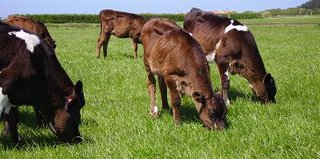
Mid-October. The calves are ten weeks old.
Tuesday, October 17, 2006
Just another brain-damaged Hereford

56 with her new calf. Although most calves would be holding their head up shaking the water out of their ears at this stage, I didn't notice anything wrong with this one.
Until the afternoon when he was still, at about six hours old, unable to stand. He was given a lift to the calfshed and, after 56 was milked, lifted to his feet. I've seen many calves over the years that don't stand on their first day, and almost always the problem is contracted tendons which gradually improves, and by about four days they're on their feet like normal calves. This fellow doesn't have a problem with his legs though. He's swaying on his feet almost toppling over, then every few seconds he swings suddenly the other way, a start as if he's just woken up, or is belatedly trying to balance.
This calf has zero sense of balance.
He collapses gracefully to the floor as soon as he is allowed to fall, and is bottle-fed while sitting up. Twice a day this is repeated - the calf is lifted to his feet and assisted to stand. On his own, he tries and tries to get up and flops around the floor. By two days old there is no improvement, and I'm starting to consider that his future is going to involve a deep hole in the earth. Then that evening his balance seems marginally improved - so good in fact, that he sucks his bottle while standing as I only need to hold a hand on his side to keep him from toppling over.
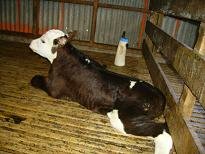
That's around the time this photo was taken. Ready for his feed, he struggles valiantly to rise alone.
By four days old he has mastered the art of 'crawling', using his front legs to pull himself around while the back ones paddle along behind.

On day five I helped him to stand and gave him his bottle, then walked away from him and left him standing unassisted for the first time.
Of course there had to be a photo of the momentous occasion.

And here he is just looking cute.
The following morning when I turned up with his feed he stood up on his own. By the next day he had taken his first steps - lurching, unbalanced ones, but good enough to allow him to move around the pen with his legs straight, rather than the close to the floor crawling position he adopted formerly.
This morning I put two younger calves in with him (so that I could concentrate on teaching the younger still calves to drink without getting head-butted) and he drank with them from the teated bucket instead of getting his own bottle. At nine days old, he is fully mobile but doesn't yet look normal - his hind legs curve outwards, making him appear much shorter than he actually is and his walk is still ungainly.
He's holding his own well with the other calves.
At this stage, I've lost count of the number of brain-damaged Herefords I've seen this season. As soon as AB finished and the Herefords started arriving I noticed that they took about twice as long as the dairy calves - 4 to 6 feeds rather than two or three - to get to the stage where you could put the milk in front of them and leave them to feed on their own.
Then a calf that had been delayed going on the bobby truck because of a slight scour suddenly lost the ability to stand and showed signs of brain damage (CCN/lead poisoning symptoms - neck straight up, blindness). By then he was over a week old. He caught the slink truck the next day.
A pretty little heifer, twice as heavy as she looked (I carried her in from the paddock) lay on the floor for two days while the other calves stumbled over her before she successfully found her feet and was able to join the others at the communal feeder and a few days later, on the bobby truck.
Seven late calves one day, including a set of twins and by morning the little bull twin had developed a scour and lost the ability to stand. Too busy to even wonder what had happened, I ensured he caught the next slink truck.
This morning another Hereford, walked all the way home yesterday but by nightfall was too weak to stand and refusing to feed. He left life unassisted during the night.
For the first few weeks I figured the slowness to catch on to life was a trait of the breed, but I mentioned it to a vet who didn't think so, voicing the possibility of BVD infection at a critical stage of these calves' development.
Thus far, four brain damaged calves and 56's calf may be the first of those to leave the farm alive. At least half of the remaining calves remarkably slow. The cause may never be known, but I doubt I'll ever have a Hereford bull anywhere near the cows again.
Monday, October 16, 2006
Transition cow

Number 56, within a couple of hours of downcalving. Note the drippping milk - usually a useful sign that calving is imminent.

Here she is, about three hours later.
I'd like to have taken a nice photo of 56 with lively calf at foot, but her calf did not stand that day, and got a lift home on the tractor while Mamma rejoined the milking herd. Here instead is 115 heading off with her twelve-hour old calf anywhere as long as it's away from the camera.
Saturday, October 14, 2006
Thursday, October 12, 2006
Food for busy farmers
Not quite as simple as toast, but worth it:Roll out half a 400g block of bought puff pastry (do the same tomorrow, or throw the other half on top of a casserole tonight). Make a nice big square, then cut it into four. Take two small eating apples, peel, core and dice into a bowl and add a handful of raisins, then mix. Place a quarter of the mix on a corner of each of the four squares and endeavour to fold each pastry square into a triangle, using whatever means are at your disposal to make the edges meet over the diced apple.
Place the apple turnovers on a lightly oiled tray, sprinkle them with allspice and rub about half a teaspoon of honey over the top of each turnover. Bake at 180 C until the pastry is risen and the honey your preferred shade of black. Eat two with dinner, two on your way out to milking in the morning.
Would-be guzzlers should be easily dissuaded if shown the hands that made them, accompanied by an oblique reference to bugs (without any mention of the likelihood of bugs surviving ten minutes at 180 C).
Tuesday, October 10, 2006
Stupid quote of the day
Voracious appetites and production ability far above today's average cow will typify Kiwi cows in 10 years time quoth Dexcel.(in whatsoever manner Dexcel quoteth - it is to be presumed; through some human individual who is of course entirely unswayed by his own thought processes and speaks only for the inimitable Dexcel)
Hello? My cows today don't have voracious appetites? But in ten years time they will? Production ability will exceed... but what, my dear Dexcel, would I do with production ability exceeding the 8-900 kg MS or so the average 2000-born Kiwi cow would be capable of on a fully balanced diet?
Hmm...


